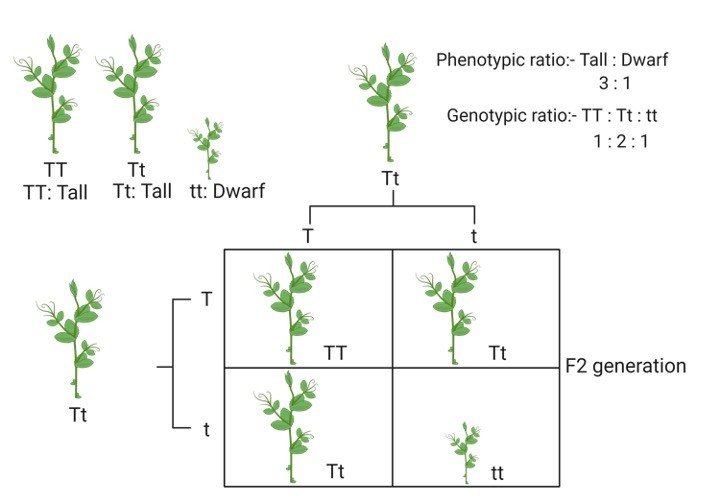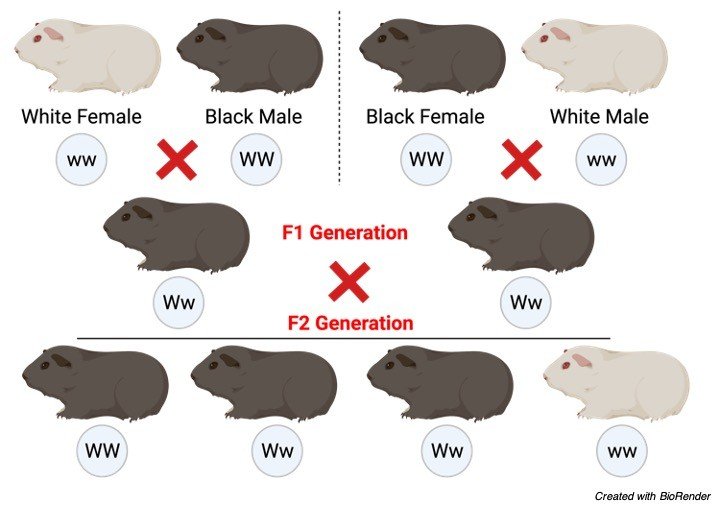What is Mendel’s Law of Dominance?
In hybridization techniques, two alleles are considered one as dominant character and other as recessive character when these alleles are let to undergo fertilization by crossing techniques the expression of dominant allele will be high compared to that of recessive allele phenotypically.
Hence the dominant character will be expressed and it is known as law of dominance.
Law of dominance is also said to be Mendel’s first law of inheritance.
Pea Plant and Law of Dominance
Mendel experimented an edible pea plant which is scientifically known as Pisum sativum, which gave him tremendous results and thus sativum is considered as the best hybridization material for experiments.
The seven contrasting characters of pea plants include size as tall and dwarf, color of the cotyledon as green or yellow, seeds may be round or wrinkled, seed coat is colored or not, whether the flowers position is axial or terminal, the flower color is red or white.
The plants with these contrasting characters are led to cross pollinate and the characters of upcoming generations are noted.
The table given below shows the seven pairs of contrasting characters in a Mendel’s pea plant.
| Character | Dominant Trait | Recessive Trait |
| Seed Shape | Round | Wrinkled |
| Seed Color | Yellow | Green |
| Flower Color | Violet | White |
| Pod Shape | Full | Constricted |
| Pod Color | Green | Yellow |
| Flower Position | Axial | Terminal |
| Stem Height | Tall | Dwarf |
Phenomenon in Law of Dominance
When a monohybrid cross is made between tall and dwarf pea plants, all plants are tending to appear to be tall in first F1 generation.
Again when these F1 plants are let to undergo self-fertilization both the characters tall and dwarf tend to appear in the second F2 generation.
Hence it is concluded that the dwarf character is dominated by the tall character.


Thus, Mendel concluded the phenomenon of dominance as When a crossing occurs between homozygous organisms of different characters, only one character or allele is expressed in the first filial generation.
Law of Dominance Mechanism
On undergoing various experiments, Mendel evidenced himself that there will be difference in their genetic characters even though the phenotypic character resembles as such their parents.
Because the character does not remain the same as it is being for their parents.
Therefore, there will be something which controls all these characters which are later found as genes which are the units of DNA (Deoxyribo nucleic acid) or RNA (Ribo nucleic acids) accordingly which are present in the chromosomes of an individual and are passed on to the next generation through parents via gametes of male and female.
Hence the individual has 23 pair of chromosomes each pair from one of the parents, each chromosome consists of genes as their functional unit which consists of contrasting characters made up of alleles.
If there are two or more contrasting pair of alleles then it is said to be as allelomorph.
These alleles are produced as the effect of mutation in a wild gene.
For example, let us consider a pea plant, where homozygous tall plant has two alleles such as TT on their gene loci in their homologous chromosomes and homologous dwarf plants is represented by the allele tt.
During the process of gametogenesis, the two homologous alleles TT and tt are separated and each chromosome contains a single allele as T and t and it is passed via gametes.
These alleles which are passed through gametes of both the parents (father and mother) combine together during fertilisation.
Thus, the new individual in the F1 generation has two different alleles and it is referred to as heterozygous in condition.
The dominant character is being expressed and the recessive character of the individual gets suppressed this the mechanism why only dominant characters are expressed though the individual has both the alleles.
Examples of Law of Dominance
Several geneticists tested this phenomenon of dominance in both the plants animals and they are as follows.
1. Pea Plants (Pisum sativum)
As tested by Mendel Plants such as pea plants (Pisum sativum) shows the phenomenon of dominance, as mentioned above.
2. Animals (Guinea Pig)
The phenomenon of dominance is experimentally proven in animals as in plants.
To show the phenomenon of dominance guinea pig is selected, such that when a homozygous colored black and white guinea pigs are crossed together, all the hybrids of filial one generation are found be black phenotypically.
When this F1 hybrids are let to self-fertilize they produce black and white offspring’s in the phenotypic ratio of 3:1.

Hence it is concluded that black color dominates over a white color and dominancy is experimentally proven in coat color of the animals.
3. Characters in Human
Human consists of both dominant and recessive characters in each parts of the body contrasting to one another where one as the mother (female) and the other as the father(male).
The examples of these characters include hair, skin epidermis, fingers, structure, ear lobe, tongue, teeth etc.


